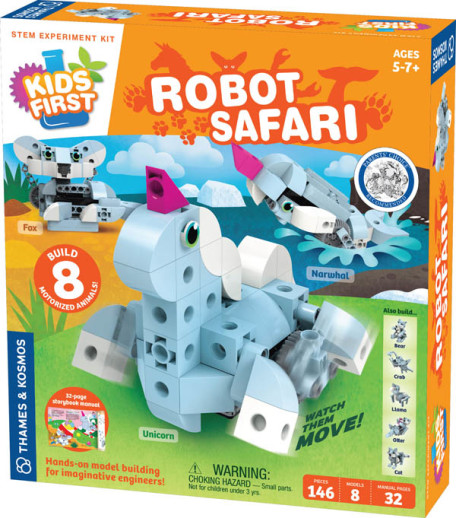We use cookies to make your experience better. To comply with the new e-Privacy directive, we need to ask for your consent to set the cookies. Learn more.
Robot Safari (Kids First Level 2)
Engineering and robotics perfect for young children! This creative kit takes young engineers on an engaging journey as they build different animal models. The colorful 32-page storybook follows a robotic teddy bear on a safari where he meets other robotic animals including a polar bear, narwhal, crab, unicorn, sea otter, cat, fox, and llama. Kids use the 146 pieces with a battery-powered motor to build each model and see how they move in their own unique ways. Two AA batteries required, not included. ~ Megan
1.
Build a series of adorable, motorized robotic animals with this introductory mechanical engineering kit for kids ages five and up. A beautifully illustrated 32-page storybook centers around the adventures of the Omegas the family of makers and engineers featured in other Kids First early engineering kits.
When Remus, the familys robotic teddy bear, finds himself separated from the rest of his family, he embarks on a fun-filled safari adventure. Along the way, Remus encounters eight different robotic animals from all over the globe: a polar bear, cat, narwhal, crab, fox, baby llama, unicorn, and sea otter. As they follow the story, kids can build models of these robots and experiment with them to see how each one uses the battery-powered motor and mechanical parts to move in a different way. Large, cubic plastic building pieces make it easy for small hands to put the models together.
Robot Safari provides an engaging way to teach simple engineering concepts to young children, allowing parents, teachers, and caregivers to lay the groundwork for strong STEM-related skills and comprehension at an early age. Model building and experiments develop fine motor skill, mechanical engineering skills, visual-spatial skills, and reasoning and concept development skills.
This great new series is for your youngest engineers and scientists. Level 1 is for ages 3 to 5, and level 2 is for 5 to 7. This is a brand new line for Thames and Kosmos and is intended to introduce young learners to science and math concepts while also developing fine motor skills and visual/spatial reasoning. At level 1, the building is accompanied by an engaging storybook (24 pages in length), pretend play, and simple activities. The activities reflect the content of the story line and use chunkier building pieces that are great for smaller hands. Each kit comes nicely packaged in a durable storage container.
Level 2 takes children to the next level of science there are no storybooks, but a detailed 48-page, illustrated guide book comes in every kit. These kits introduce children to the scientific method and teach science basics using hands-on experiments. Level 2 kits do not have a storage container.
| Product Format: | Other |
|---|---|
| Brand: | Thames and Kosmos |
| Grades: | K-2 |
| EAN/UPC: | 814743014107 |
| Length in Inches: | 11.1875 |
| Width in Inches: | 10.0625 |
| Height in Inches: | 2.5625 |
| Weight in Pounds: | 1.25 |

